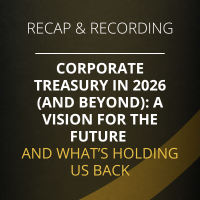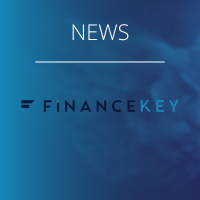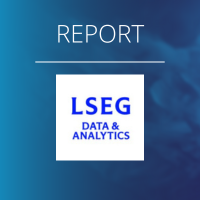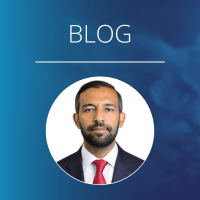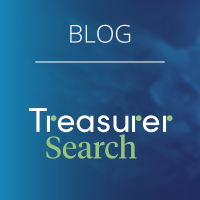There are good reasons to be confident about the prospects for mergers and acquisitions in 2025. The US regulatory climate is expected to loosen under a second Trump administration, corporates have pent-up cash reserves to spend, and interest rates are expected to remain at current levels or drop in the near term.
A surge in M&A activity would be good news for private funds, but will require savvy data management, so GPs can access and deploy their internal data for a faster, more rigorous investment process, says Thomas Gavaghan, a VP of global presales for the global leader in liquidity performance solutions Kyriba.
Q: What do you expect the private funds landscape to look like in 2025?
Let’s start with what our proprietary research says. Kyriba found that corporate liquidity for companies in the US has reached $3.5 trillion out of combined revenues of $16 trillion which is a 20 percent liquidity-to-revenue ratio. The highest level since
2021, yet M&A deals are currently 2,000 fewer total transactions in volume, suggesting a ‘wait and see’ stance among corporations. And we see liquidity as a leading indicator of M&A activity.
There’s really been this hoarding of cash for years now, where corporates have been shifting their capital structure to stockpile cash given the high levels of uncertainty. Now there’s a stabilization period, where even though it’s a high interest rate environment, it’s a stabilized one. The Fed recently said while they might consider cutting rates, they might not in the near term, just to prolong the current stability.
So the next question is what will corporates do with all that liquidity? And the sense is that it will be channeled into M&A activity, at pre-covid levels. That comeback is also likely to be helped by the sense that the regulatory environment will be more enticing, since we already saw what the first Trump administration did, and we can expect some continuation of that stance.
What complicates the regulatory climate is expected anti-money laundering reforms and ESG demands, which will leave market participants a little more cautious as well, with an eye to making sure that they are fully compliant with current expectations. And at a macro level, the discourse around tariffs can’t be ignored.
The potential for increased tariffs in the US could lead to companies seeking supply chain realignment to focus on domestic production in order to mitigate the potential impact, as in, looking to merge or acquire with companies that have the capabilities they need domestically, in a certain amount of regionalization, or as I would put it, a move away from centralization to a controlled decentralization. So, GPs will have to navigate these various pockets, even as the overall M&A market picks up steam.
Q: What should private funds managers be doing now, or in the first few months of 2025 to prepare for all that M&A activity?
For private funds, or really any sector right now, a lot of the focus is around data: access to it and information around it so that it can be easily acted upon. And the promise of AI is fueling this even more, as that technology requires robust, accurate data.
But strictly from a private funds manager’s perspective, one of the key priorities is gaining and ensuring complete visibility of liquidity so that they know where it is, what they have, what they don’t have, what they can tap into on their credit facilities within capital calls and things like that. This requires centralizing that information to make sure that it’s not living inside of different spreadsheets owned by different managers. Placing it in a single spot where it can be accessed is key.
There’s also the planning aspect around data management. So, that private funds manager may know where they are today, but they want to know where can they take things tomorrow. Having data centralized is obviously key to that as well. GPs want to be able to devise investment plans, for instance, and see how cash flow impacts those plans. They want to be able to then measure what they’re doing with debt and equity and plan accordingly, which only happens with centralized data.
The third layer of that is navigating these other pressing regulatory demands that we now expect to be the norm, from anti-money laundering, and ESG inquiries. Centralized data will be key to answering questions from regulators in a timely manner, as that’s not possible if the data is scattered across multiple buckets across multiple geographies. Speed matters here, and there’s no speed without centralization.
But timing isn’t just about staying compliant. It’s an essential component to staying competitive. The costs associated with either a delay or just the manual efforts can rise, and value can be lost pretty quickly. There’s still leverage involved in deals, and a lack of speed can erode the margins, and in our high interest rate environment, the cost of capital is a core concern.
For GPs wondering if they have the right capabilities and processes around their data, I’d say it’s really an IT audit first. They have to ask what does the technology stack looks like. What are they doing? And what is possible? For example, can the firm’s “house” plug into the “plumbing” or are they still going out to the “well”? Some legacy systems just don’t offer interconnectivity or if they do, it’s not timely.
So, there is an IT-level conversation about the technology stack, about what it does and what it can do, and then the question of where does the data need to go? It’s really moved from, “How do I manage my day-to-day cash operations, to how do we connect your system to these, you know, 14 other platforms internally so we can centralize our information for planning, for payments, etc?” So, it’s not just about centralizing the data, but about making sure it can be distributed to all the other relevant platforms.
Generative AI, which is very different from machine learning, will have a role to play, but the other priority I’d love for private funds GPs to tackle is integrating their portfolio company data into that centralized hub, so that it really captures the entire ecosystem of relevant data, that can then be tapped to make faster, better decisions, no matter the market. But for now, we’ll be glad to see centralized data practices at work in taking advantage of the opportunities to come.



